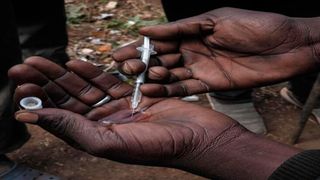
A 30-year-old male drug addict prepares to inject heroin at Kawangware slum in Nairobi, Kenya, on January 22, 2021.
| Yasuyoshi Chiba | AFPLamu
Premium
Heroin, cocaine fuel the streets of Lamu
The most peddled and used drugs in Lamu County are cocaine and heroin, both locally known as unga (flour), and bhang.
The Lamu security department has also revealed other drugs such as miraa (muguka), illicit brews, over the counter medicine and other subscription drugs as rampantly abused drugs in the region.
The abused hard drugs like cocaine, heroin and bhang are ferried in from far-flung areas of the Kenyan coastline such as Shimoni in Kwale and Mombasa counties and upcountry.
They find their way to Lamu on vehicles and boats, hidden inside boxes with clothing, onions, perfumes, packets of flour and other household items that make it hard for security agencies to spot them.
Speaking to the Nation on Saturday, Lamu County Commissioner Irungu Macharia said the biggest challenge was the fact that the local community is unwilling to speak or cooperate on the war on drugs.
Instead, the community shields drug peddlers, providing an environment for the illicit trade to thrive.
Mr Macharia noted that the fact that the community was also a ready market for the drugs was part of the reason the war on drugs was being frustrated.
The county commissioner feels if there is no demand for drugs, there will be no place for drug dealers and peddlers to survive in the region.
He appealed to locals to feel free to expose drug dealers so they can face the law.
“As a fact, abuse of drugs and substance that include bhang, unga, miraa, muguka, illicit brews, over the counter medicine and other subscription drugs is rampant in the county. We are very concerned as law enforcement agencies. However, the community is failing us by refusing to name those involved in the business. They won’t tell us who the drug dealers are, plus they protect them. This needs to change if we have to save Lamu and the generations to come,” said Mr Macharia.
He added, “As security, we are alert and committed to ridding Lamu of drugs but we need to work with the community to win this. That’s why we won’t despair in appealing for cooperation from locals,” he said.
The commissioner, however, said a crackdown on drug peddlers and smugglers will continue indefinitely in Lamu until all those involved are caught and prosecuted.
Chiefs and their assistants have been directed to take charge of the war on drugs in their areas.
“We need to unite and say no to drugs. Report these dealers so that we can put them behind bars and make the society a better place for our youth and children,” said Mr Macharia.
Places that are notorious for drug peddling in Lamu are Langoni, Jua Kali, Gadeni, Wiyoni, Kashmir and Kandahar in Lamu town, as well as Pate, Faza, Kizingitini, Tchundwa, Myabogi and Mbwajumwali in Lamu East.
Now, elders in these areas have formed special committees that have tried to address drug use in the region.
“We have tried our best to address the menace through community meetings but still, the problem exists. Unfortunately, our youths of between 15 and 25 years have been greatly affected by the drugs, mostly heroin and bhang,” said Mr Mohamed Yusuf of Tchundwa.
Lamu County Deputy Governor Abdulhakim Aboud said through The United Nations Office on Drugs and Crime-UNODC, together with Mewa hospital, the county has established a special unit at the Lamu King Fahad Hospital to rehabilitate drug addicts.
Mr Aboud said the Medical Assistant Therapy unit has already registered more than 300 drug addicts who report to the clinic daily to receive methadone to help them in their journey to reform.
“We have listed several willing drug users who are undergoing rehabilitation at our methadone clinic at King Fahad Hospital. All these efforts are done to tame the drug menace destroying our youth in Lamu,” said Mr Aboud.
In April 2019, former Chief Justice David Maraga together with former Kenya Red Cross Society Secretary General Abbas Gullet commissioned the first drug rehabilitation centre in Lamu county, providing hope for addicts in the region who have often expressed their desire to turn a new leaf and live sober and more productive lives.
The Sh98 million facility, which is fully sponsored by the Kenya Red Cross Society, is situated at the Hindi Showground in Lamu West.
It has a capacity of 100 persons at a go.
Treatment services include detoxification, substitution or maintenance therapy and or psychosocial therapies and counselling while the duration depends on patient problems and needs.
Normally, the entire process takes 90 days.
Questions are, however, arising over the relevance and effectiveness of the rehab centre amidst the high levels of poverty in the county.
Drug addicts and affected families who were interviewed decried the high cost of the rehabilitation as a key reason behind failure to access the much-needed help at the facility, three years since its launch.
A three-month rehab session at the facility that includes taking care of the patients in terms of food, clothing, guidance and counselling, medication, family therapy sessions and training on special skills so that the reformed addicts can use to better their lives once they move out of the centre cost not less than Sh90,000.
“Where are we going to get the Sh90,000 for our drug addicts to undergo rehabilitation? The facility is extremely expensive. We’re worried our patients might never get to receive the much-needed rehab services to enable them to deal with the negative effects of drugs. Let these services be made free of charge,” said Mrs Sada Mudathir.





